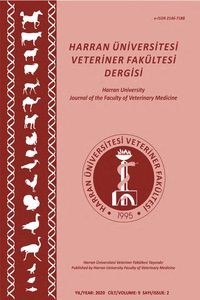Köpeklerde Vektör Kaynaklı Hastalıkların Araştırılması
Abstract
Bu çalışmada, Türkiye'nin beş farklı ilindeki (Mersin, Adana, Hatay, Gaziantep ve Batman) köpek barınaklarından alınan 186 (104'ü erkek ve 82'si dişi) kan örneği vektör kaynaklı nakledilen patojenler yönünden moleküler yöntemlerle araştırıldı. İncelenen örneklerin %10.8'inin en az bir veya birden fazla patojen ile enfekte olduğu tespit edildi. Ehrlichia canis (17/186; %9.1) en yaygın vektör aracılı nakledilen patojen olup, bunu sırasıyla Babesia canis vogeli (5/186; %2.7) ve Hepatozoon canis (1/186; %0.5) izledi. E. canis ve B. canis ortak enfeksiyonu 3 (%1.6) köpekte tespit edildi. Rickettsia spp., Coxiella burnetii, Borrelia burgdorferi s.l., Francisella tularensis, Bartonella spp., Leishmania spp., Diroflaria immitis, Diroflaria repens ve Acanthocheilonema reconditum enfeksiyonu saptanmadı. Vektör aracılı nakledilen patojenler yönünden pozitif bulunan köpeklerde yaş ve cinsiyet yönünden istatistiksel olarak önemli bir fark belirlenmedi (p> 0.05). Çalışılan illerde köpeklerde vektör aracılı nakledilen patojenlerden üçünün varlığı gösterilmiş ve çalışılan illerde ilk kez B. canis ve H. canis varlığı tespit edilmiştir.
Project Number
This work was supported by the Hatay Mustafa Kemal University Scientific Research Fund under Grant number of 20.M.028.
References
- Aktaş M, Özübek S, Sayın Ipek DN, 2013. Molecular investigations of Hepatozoon species in dogs and developmental stages of Rhipicephalus sanguineus. Parasitol Res, 112, 2381-2385.
- Aktaş M, Özübek S, Altay K, Sayın İpek ND, Balkaya İ, Utuk AE, Kırbaş A, Şimsek S, Dumanlı N, 2015a. Molecular detection of tick-borne rickettsial and protozoan pathogens in domestic dogs from Turkey. Parasites & Vectors, 8, 157.
- Aktaş M, Özübek S, Altay K , Balkaya İ, Utuk AE, Kırbaş A, Şimsek S, Dumanlı N, 2015b. A molecular and parasitological survey of Hepatozoon canis in domestic dogs in Turkey. Vet Parasitol, 209, 264-267.
- Aktaş M, 2014. A survey of ixodid tick species and molecular identification of tick-borne pathogens. Vet Parasitol, 200, 276–283.
- Aktaş M, Özübek S, İpek DN, 2013. Molecular investigations of Hepatozoon species in dogs and developmental stages of Rhipicephalus sanguineus. Parasitol Res, 112, 2381–2385.
- Aysul N, 2006. Comparison of microscopic and PCR-RLB findings in detection of Babesia species of dogs in Istanbul. PhD Thesis, Istanbul University, Institute of Health Science, Parasitology Department, Istanbul, Turkey.
- Baneth G, 2011. Perspectives on canine and feline hepatozoonosis. Vet Parasitol, 181, 3–11.
Investigation of vector-borne diseases in dogs
Abstract
In this study, a total of 186 blood samples were collected from kennel dogs consisting of 104 male and 82 female in five provinces (Mersin, Adana, Hatay, Gaziantep and Batman) of Turkey, and evaluated using molecular methods for the presence of canine vector-borne diseases (CVBDs). Overall, 10.8% of the sampled dogs were found to be infected with one or more CVBD pathogens investigated. Ehrlichia canis (17/186; 9.1%) was the most common CVBD pathogen, followed by Babesia canis vogeli (5/186; 2.7%) and Hepatozoon canis (1/186; 0.5%), respectively. Co-infection of E. canis with B. canis was detected in 3 (1.6%) dogs. Infection with Rickettsia spp., Coxiella burnetii, Borrelia burgdorferi s.l., Francisella tularensis, Bartonella spp., Leishmania spp., Diroflaria immitis, Diroflaria repens, and Acanthocheilonema reconditum were not detected. No sex association with CVBDs was determined (p>0.05). The result of the study indicates the presence of three CVB pathogens, including the first report of B. canis and H. canis in the studied provinces.
Supporting Institution
Hatay Mustafa Kemal University
Project Number
This work was supported by the Hatay Mustafa Kemal University Scientific Research Fund under Grant number of 20.M.028.
Thanks
The authors would like to thank Prof. Dr. Alpaslan YILDIRIM (Erciyes University, Faculty of Veterinary Medicine, Department of Parasitology) for obtaining D. immitis positive control.
References
- Aktaş M, Özübek S, Sayın Ipek DN, 2013. Molecular investigations of Hepatozoon species in dogs and developmental stages of Rhipicephalus sanguineus. Parasitol Res, 112, 2381-2385.
- Aktaş M, Özübek S, Altay K, Sayın İpek ND, Balkaya İ, Utuk AE, Kırbaş A, Şimsek S, Dumanlı N, 2015a. Molecular detection of tick-borne rickettsial and protozoan pathogens in domestic dogs from Turkey. Parasites & Vectors, 8, 157.
- Aktaş M, Özübek S, Altay K , Balkaya İ, Utuk AE, Kırbaş A, Şimsek S, Dumanlı N, 2015b. A molecular and parasitological survey of Hepatozoon canis in domestic dogs in Turkey. Vet Parasitol, 209, 264-267.
- Aktaş M, 2014. A survey of ixodid tick species and molecular identification of tick-borne pathogens. Vet Parasitol, 200, 276–283.
- Aktaş M, Özübek S, İpek DN, 2013. Molecular investigations of Hepatozoon species in dogs and developmental stages of Rhipicephalus sanguineus. Parasitol Res, 112, 2381–2385.
- Aysul N, 2006. Comparison of microscopic and PCR-RLB findings in detection of Babesia species of dogs in Istanbul. PhD Thesis, Istanbul University, Institute of Health Science, Parasitology Department, Istanbul, Turkey.
- Baneth G, 2011. Perspectives on canine and feline hepatozoonosis. Vet Parasitol, 181, 3–11.
Details
| Primary Language | English |
|---|---|
| Subjects | Veterinary Surgery |
| Journal Section | Articles |
| Authors | |
| Project Number | This work was supported by the Hatay Mustafa Kemal University Scientific Research Fund under Grant number of 20.M.028. |
| Publication Date | December 23, 2020 |
| Submission Date | September 8, 2020 |
| Acceptance Date | November 16, 2020 |
| Published in Issue | Year 2020 Volume: 9 Issue: 2 |


